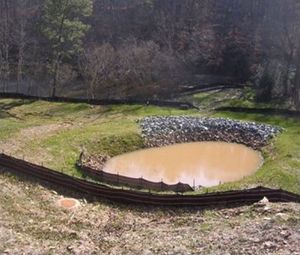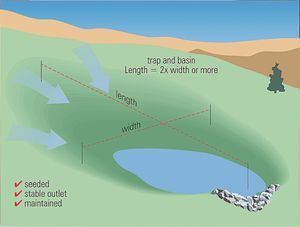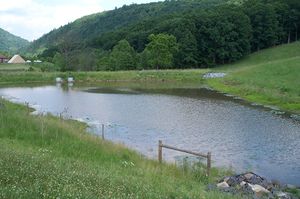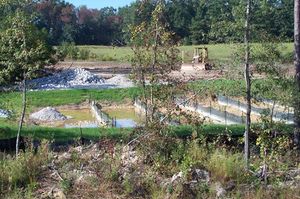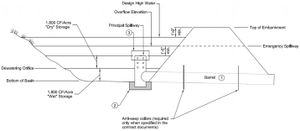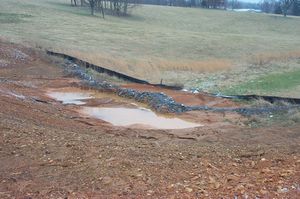
Sediment control practices - Sediment traps and basins
Sediment traps and basins are settling ponds formed by excavation and/or an embankment that intercept and retain sediment-laden runoff from a construction site for a sufficient period of time to allow the majority of sediment to settle out prior to being released from the site. They may be constructed as smaller sediment traps – serving disturbed areas of less than five acres – or as larger sediment basins, handling mass grading runoff from subdivisions, commercial/institutional sites, or roadway projects. Proper use of these structures can greatly reduce sediment transport off-site; if properly designed, installed, and maintained, sediment removal efficiency of 80% or greater can be achieved, depending on soil particle size. Sediment traps are often temporary and usually decommissioned after the disturbed area is stabilized (i.e., with vegetation or other cover). Temporary sediment basins can be converted to permanent stormwater management basins after construction is complete. Sediment traps and basins are very useful on construction sites with moderate to steep slopes. The selection of traps versus basins primarily depends on the size of the contributing drainage area and plans for post-construction stormwater management, as discussed below.
Contents
Purpose and function
Sediment traps retain runoff using embankments and other barriers and discharge treated water through an overflow or piped outlet to a vegetated swale or other drainage feature. Sediment basins are typically larger than sediment traps and may feature earthen embankments that retain runoff for longer periods of time, releasing runoff via floating, perforated, or slotted risers, or when the water level exceeds the height of the riser pipe in the outlet structure.
Applicability
Sediment traps and basins represent one of the most effective and reliable measures for treating sediment-laden runoff from construction sites. These structures are typically placed near the perimeter of the site, where flows concentrate in swales, ditches, or other low areas. Phasing of construction activities should allow sediment traps and basins to be utilized before upslope areas are disturbed, if possible, and until the contributing drainage area is fully stabilized. Specific considerations related to site applicability and permit applicability are discussed below.
Site applicability
Disturbed soils on a construction site have the potential to leave the site via stormwater runoff and negatively impact receiving waters, roadways, and neighboring property. Sediment traps and basins should intercept concentrated or sheet flows of stormwater discharge from a construction site. Place sediment traps near the point of discharge and build traps in series to intercept and treat flow moving down long drainage paths through a site. Place stormwater basins in low lying areas on the outer edge of a construction site where water naturally flows or is directed according to site plans. Sediment traps are particularly useful in perimeter control areas where silt fences will likely fail. Do not site sediment traps in high-velocity flow areas (e.g., culvert outlets, steep ditches) where excessive turbulence and scour erosion may interfere with sediment settling processes. Neither practice should be placed in surface waters (including intermittent streams) or within their required buffer zones.
Permit applicability
Section 14 (Temporary Sediment Basins) of the MPCA Construction Stormwater General Permit (2018) has several requirements regarding sediment basins, including the following.
- Section 14.2: Temporary sediment basins are required where ten (10) or more acres of disturbed soil drain to a common location. If the acreage of disturbed soil is reduced to less than ten (10) acres due to establishment of permanent cover, the temporary basin is no longer required. Permittees may convert temporary sediment basins to permanent basins after completion of construction.
- Sections 14.3 and 14.4: For each acre of land that drains to the basin, the basin must provide sufficient live storage to hold runoff from a 2-year 24-hour storm event or provide 1,800 cubic feet of live storage, whichever is greater. Where permittees have not calculated the two (2)-year, 24-hour storm runoff amount, the temporary basin must provide 3,600 cubic feet of live storage per acre of the basins' drainage area.
- Sections 14.5, 14.6, and 14.7: Outlet structures must prevent short-circuiting and discharge of floating debris, withdraw water from the surface of the sediment pond, and have sufficient energy dissipation for the outlet within 24 hours after connecting to a surface water.
- Sections 14.8 and 14.9: Temporary basins must be located outside of surface waters and applicable buffer zones. Temporary basins must be constructed prior to disturbance of ten (10) or more acres of soil draining to a common location.
- Section 14.10 The general construction permit allows other effective sediment controls (e.g., a series of smaller sediment basins and/or sediment traps, silt fences, vegetative buffer strips, etc.) if sediment basin requirements are infeasible to meet on a particular site. This determination must be documented in the SWPPP (Stormwater Pollution Prevention Plan).
Specific permit language
Applicability
- Specifically, section 14.2 of the MPCA Construction Stormwater General Permit (2018) states: “Where ten (10) or more acres of disturbed soil drain to a common location, permittees must provide a temporary sediment basin to provide treatment of the runoff before it leaves the construction site or enters surface waters. Permittees may convert a temporary sediment basin to a permanent basin after construction is complete. The temporary basin is no longer required when permanent cover has reduced the acreage of disturbed soil to less than ten (10) acres draining to a common location. “
Sizing
- Section 14.3 states: “The temporary basin must provide live storage for a calculated volume of runoff from a two (2)-year, 24-hour storm from each acre drained to the basin or 1,800 cubic feet of live storage per acre drained, whichever is greater.”
- Section 14.4 states: “Where permittees have not calculated the two (2)-year, 24-hour storm runoff amount, the temporary basin must provide 3,600 cubic feet of live storage per acre of the basins' drainage area”.
Outlets
- Section 14.5 states: “Permittees must design basin outlets to prevent short-circuiting and the discharge of floating debris.”
- Section 14.6 states: “Permittees must design the outlet structure to withdraw water from the surface to minimize the discharge of pollutants. Permittees may temporarily suspend the use of a surface withdrawal mechanism during frozen conditions. The basin must include a stabilized emergency overflow to prevent failure of pond integrity.”
- Section 14.7 states: “Permittees must provide energy dissipation for the basin outlet within 24 hours after connection to a surface water.”
Location and timing
- Section 14.8 states:“Permittees must locate temporary basins outside of surface waters and any buffer zone required in item 23.11 of the general permit.”
- Section 14.9 states: “Permittees must construct the temporary basins prior to disturbing 10 or more acres of soil draining to a common location.”
Alternatives
- Section 14.10 states: “Where a temporary sediment basin meeting the requirements of item 14.3 through 14.9 is infeasible, permittees must install effective sediment controls such as smaller sediment basins and/or sediment traps, silt fences, vegetative buffer strips or any appropriate combination of measures as dictated by individual site conditions. In determining whether installing a sediment basin is infeasible, permittees must consider public safety and may consider factors such as site soils, slope, and available area on-site. Permittees must document this determination of infeasibility in the SWPPP”.
Additional information on basin drainage is provided in Construction stormwater treatment - dewatering.
Effectiveness
When designed, installed, and maintained properly, sediment traps and basins have sediment-trapping efficiencies typically between 60 and 80 percent. They need little maintenance compared to other practices that treat sediment-laden runoff, provided upland areas are brought to final grade and stabilized promptly. Sediment traps and basins provide good control of coarse sediment and are moderately effective for trapping medium-size sediment particles. However, they have a relatively low trapping efficiency for fine silt and clay particles suspended in runoff. Longer detention times, use of a flocculant, or additional sediment control measures may be necessary for removal of finer-textured sediment. In general, the larger the storage volume and the longer the detention time of the stormwater, the more efficient sediment basins are at removing finer particles. Oil, grease, and other floatables may also be removed if using an outlet pipe that features perforated openings, a screen, a skimmer, or other means to draw ponded water from just below the surface. Effectiveness in removing floatables is dependent on the outlet design.
Expected performance for temporary/permanent sediment traps and basins.
Link to this table
| Water quantity | |
|---|---|
| Flow attenuation | Secondary design benefit |
| Runoff volume reduction | Secondary design benefit |
| Water quality | |
| Erosion prevention | Little or no design benefit |
| Sediment control | Primary design benefit |
| Nutrient loading | Secondary design benefit |
| Pollutant removal | |
| Total suspended solids | Primary design benefit |
| Total phosphorus | Secondary design benefit |
| Heavy metals | Secondary design benefit |
| Floatables | Secondary design benefit |
| Oil and grease | Secondary design benefit |
Planning Considerations
Sediment Traps
A well-functioning and well-placed sediment trap is key to preventing off-site migration of sediment. They should be installed before the site clearing phase begins. Consider the natural drainage of a construction site prior to planning sediment trap size and location. Locate areas of potential sediment runoff, determine the likely pathway for water draining from those sites, and place sediment traps between the source of sediment and the site perimeter or water body that will receive the runoff. For maximum effectiveness, place sediment traps as close as possible to the source of sediment runoff. If the site configuration prevents the use of a single sediment trap, use multiple smaller traps arranged in series to meet the design requirement.
Sediment Basins
If sediment traps are not sufficient for stormwater and sediment control,use sediment basins due to their larger capacity. Basins have a larger footprint than sediment traps and should be sited at a low point on the construction site, where runoff converges. If stormwater does not naturally flow towards the sediment basin and cannot feasibly be directed to it, a series of sediment traps or other BMPs may be more appropriate for sediment control. It is recommended that the slopes around the basin be greater than 1 percent but no more than 25 percent to promote flow towards the basin. Similar to sediment traps, install sediment basins prior to soil disturbing activities wherever possible. When selecting an area to place a sediment basin, look for areas that meet the following recommendations.
- Capable of storing sediment and stormwater from as much of the planned disturbed area as practical
- Provide access for maintenance throughout the project
- Are far enough away (minimum of 20 feet of separation) from existing building foundations to preserve their integrity
- Where groundwater levels will be lower than the basin bottom
- Limit treatment to runoff from disturbed areas only
- Minimally interfere with the construction site
Temporary sediment basins are often converted to permanent stormwater management structures once all disturbed contributory drainage areas have been permanently stabilized and approved by a stormwater inspection entity and all storm drains have been flushed. The outlet structure must be installed in accordance with an approved stormwater management design plan. Additional grading may be necessary to achieve the required storage volume of the basin. Prior to transition to a post-construction stormwater basin, the basin must be cleared of accumulated sediment, fully stabilized, and inspected to ensure that side slopes and the volume, containment berm, outlet, and inlets comply with stormwater basin design requirements. Link here for design information for permanent stormwater ponds.
Design
Sediment traps
A temporary sediment trap should only be used in a location with a drainage area of five (5) acres or less and where it will be used for two years or less.
Sediment traps must have an outlet to carry runoff from the structure. The outlet can be a pipe outlet, stabilized rock outlet, or other suitable structure. The outlet must be capable of handling the runoff from a 2-year-frequency, 24-hour-duration storm without failure or significant erosion. Overflow outlets should be stabilized with coarse aggregate and/or riprap and geotextile fabric.
Sediment trap sizing is dependent on the anticipated drainage area and volume of stormwater to treat. A side slope ratio of 2:1 or flatter is recommended for sediment traps. A minimum length to width ratio of 2:1 should be provided, and the distance between the inlet and outlet should be maximized to increase sediment removal efficiency. Where flow paths are shortened due to tight site conditions, silt fencing can be used as baffles within the trap to slow flows through the trap and increase sediment removal.
The example design table below provides general guidance on sizing sediment traps based on contributing drainage area. As a rule of thumb, a total storage volume of 3,600 cubic feet should be provided for every acre of contributing drainage. This volume may be equally divided between wet (retention) and dry (drawdown, or dewatered) storage. Wet storage is provided in a permanent pool and dry storage provides extended settling time.
Sediment trap sizing table
Link to this table
| Drainage area (ac) | Total Volume (ft3) | Wet Volume (ft3) | Dry Volume (ft3) | Minimum Depth (ft) | Depth of Permanent Pool (ft) | Minimum Bottom Length (ft) | Minimum Bottom Width |
|---|---|---|---|---|---|---|---|
| 1 | 3600 | 1800 | 1800 | 2.5 | 1.5 | 46 | 23 |
| 2 | 7200 | 3600 | 3600 | 2.75 | 1.5 | 64 | 32 |
| 3 | 10800 | 5400 | 5400 | 3.0 | 1.75 | 76 | 38 |
Table assumes 2:1 side slopes; Minimum depth is from trap bottom to weir crest and includes both wet and dry storage
Embankments are located at the lowest point of the sediment trap and typically consist of mixed size rock or a stabilized earthen berm with a rock-armored overflow notch. The bottom of the embankment should be level with the wet storage portion of the trap. The design table below summarizes the recommended embankment top width (also referred to as weir length) for sediment traps as a function of contributing drainage area.
Recommended embankment widths for sediment traps
Link to this table
| Contributing Drainage Area (acre) | Embankment Width (ft) |
|---|---|
| 1 | 4 |
| 2 | 6 |
| 3 | 8 |
| 4 | 10 |
| 5 | 12 |
Sediment Basins
Per the 2018 MPCA Construction Stormwater General Permit, sediment basins are required when ten (10) or more acres of disturbed land discharges to a common location. If the site is located within one mile of a special or impaired water, sediment basins are required when five (5) or more acres of disturbed land discharges to a common location. The maximum drainage area for a single sediment basin should not exceed 100 acres.
Sediment basins consist of a principal spillway, dewatering device, and an emergency (overflow) spillway. A principal spillway conveys the design volume of treated stormwater away from the site and discharges it. It consists of a vertical riser that controls basin water levels and an outlet pipe. A dewatering device releases the runoff over time, allowing the sediment to settle out. Dewatering devices can take many forms including modifications to risers and skimmers. The MPCA Construction Stormwater General Permit requires emergency spillways to safely pass stormwater from storms exceeding the basin design storm without compromising the integrity of the basin.
The total storage volume provided by sediment basins should be a minimum of 3,600 cubic feet per acre of contributing area. Contributing drainage area should include the entire drainage area, not only the disturbed area. The total storage volume should be divided equally between wet (retention) and dry (drawdown, or dewatered) storage. Storage volume is measured from the bottom of the basin to the elevation of the principal spillway crest.
The following design recommendations apply to sediment basins:
- The ratio of the surface area (ft2) at the designed high water elevation to the discharge rate from a 15-year, 24-hour storm (cfs) is greater than or equal to 0.0035.
- Basin length to width ratio should be 2:1 or greater. A ratio of 10:1 is recommended.
- Use a wedge design with the inlet located at the narrow end of the basin.
- Locate inflows to the basin as far from the riser as possible to maximize travel time through the basin and increase effectiveness of treatment. Baffles may be installed to maximize detention time and increase sediment removal efficiency.
- The embankment (dam) height should not exceed fifteen (15) feet.
- For embankments up to ten (10) feet in height, the embankment top width should be a minimum of eight (8) feet. For embankments between ten (10) and fifteen (15) feet in height, the minimum top width should be ten (10) feet.
- Design inside embankment side slopes at a ratio of 2:1 or flatter, and outside embankment side slopes 3:1 or flatter. Design all slopes to be stable through the use of erosion controls such as seeding, mulching, and sodding.
- Protect inflows and outlets from erosion by armoring with riprap or other appropriate techniques.
- Increase detention time by using rock, filter fabric, rock bags, or similar measures to modify the inlet, and use berms or other approaches that slow down exiting flow to allow more sediment to settle.
Construction recommendations and specifications
While sediment traps differ from basins in design options, sizing, and (typically) permanence, there are some basic construction recommendations common to both BMPs:
- Install traps/basins prior to disturbing large portions of the upland construction site, so they are available for sediment removal during the active construction period.
- Assess drainage toward the trap/basin to ensure it conforms to site design. Use berms or ditches to capture flows that may bypass the trap/basin where necessary.
- Design containment berms according to design and ensure soil in the berm is the proper type and compacted appropriately.
- Outlets (e.g., overflow, piped) must be stable and able to handle heavy incoming/outgoing flows.
- Ensure there are no large bottom-elevation outlet structure holes, pipe openings, rock voids in the berm, or other features that may cause the trap/basin to drain down too quickly (i.e., < 12 – 24 hrs) after a rain.
- Mixed size rock berms or filter fabric can be used, if necessary, to slow flows from permanent stormwater outlets during the construction period.
- Remove limbs, debris, trash, building materials, soil stockpiles, etc. immediately after constructing the trap/basin.
- Stabilize side slopes and berms of traps/basins with seed, erosion control blanket, stone, etc. as soon as they are built, to prevent filling the available volume with sediment from the trap/basin itself. The bottom can remain unstabilized until final sediment removal occurs.
- Ensure that stormwater discharges from the basin will exit onto an armored anti-scour pad or other erosion proof structure/area, and can move downstream via stabilized swales, ditches, channels, or as sheet flow.
- Remove any non-sediment upland materials that may wash into the trap/basin (e.g., limbs, debris, trash, building materials, etc.)
- Stabilize upland areas that may contribute significant amounts of eroded soil to the trap/basin as quickly as possible, to avoid frequent dredging and maintenance.
- Use silt fencing or other sediment controls where necessary to further reduce sediment inputs to the trap/basin – it is easier to remove sediment from a silt fence than a trap/basin.
The 2018 MnDOT Standard Specifications for Construction includes several specifications relevant to sediment basins and traps.
- MnDOT Specification 2573.3 Part A includes guidance for construction of temporary sediment basins and traps. Part A.4 (page 514) states: “Construct temporary sediment basins concurrently with the start of soil disturbing activities. Direct storm water runoff from drainage areas to the basins. Stabilize the exposed side slopes of the basins. Provide an outlet to the basin that discharges water from the surface, separates floatables, and provides scour protection or energy dissipation.” Part A.6 requires the use of a water treatment plan for these devices, stating: “Provide a water treatment plan for turbid or sediment laden water. Submit the water treatment plan to the Engineer before pumping. Do not begin work until the Engineer accepts the water treatment plan including any contractor required permits. Include in the water treatment plan the use of sediment traps, vegetative filter strips, flocculants, or other water treatments per 3875, ‘Water Treatments’.”
- MnDOT Specification 2573.3 Part P includes guidance for the maintenance of sediment basins and traps. Part P.2 (page 518) states: “Drain the basin and remove the sediment when the depth of sediment collected in the basin reaches 50 percent of the storage volume determined by the outfall device. Complete drainage and removal within 72 hours or as soon as field conditions allow access. Remove sediment to the original designed or excavated grade or as necessary to restore the function of the device. Restore stabilized condition of side slopes and access road. Clean out and shape temporary sedimentation basins intended for use as permanent water quality management basins as shown on the plans.” Maintenance is discussed in greater detail below.
- MnDOT Specification 2573.4 prescribes “method of measurement” related to temporary sediment traps and basins. Part E (Temporary Sediment Traps, page 519) states: “The Engineer will measure sediment trap excavation by volume. The Engineer will measure overflow devices separately.” Further, Part G (Sediment Removal) states: “The Engineer will measure sediment removal from temporary sediment traps and basins by backhoe hours or vac-truck hours. The spreading and hauling of sediment is incidental to the backhoe hour removal.”
- MnDOT Specification 2573.5 prescribes “basis of payment” related to temporary sediment traps and basins. Part G (Sediment Traps, page 520) states: “The Department will pay for removal of sediment from sediment traps by backhoe or vac-truck hour. Sediment spreading and disposal are incidental.” Further, Part I (Pay Items, page 521) states that payment by the Department for sediment trap excavation (Item No. 2573.504) shall be calculated on the basis of cubic yards.
- MnDOT Specification 3875 (Water Treatment) outlines requirements for use of passive dewatering treatment methods for sediment traps and basins. Specification 3875.2 Part A (page 694) states: “Use passive dewatering treatment methods, using time and gravity to settle out sediments, if draining basins, traps, ditches, or sumps to prepare the construction site for the next storm event.” Part A.2 provides specifications regarding the design of the riser pipe, stating: “Provide a riser pipe in a pond, basin, or trap outlet structure meeting the following requirements or characteristics.
- Two-thirds the height of the outlet above the floor of the structure
- Made of perforated PVC or metal pipe of the same diameter as the outlet structure
- Surrounded by clean rock from 1 in to 2 in, for the entire height of the riser pipe.
- Install a trash guard on the top overflow.”
The relevant specifications noted above in 2573.4 (Method of Measurement) and 2573.5 (Basis of Payment) are important when considering cost implications of these practices, discussed further below.
Inspection and maintenance
Sediment traps
The MPCA Construction Stormwater General Permit does not include specific requirements for inspection and maintenance of temporary sediment traps. Temporary sediment traps, however, should be inspected at least weekly and after each 0.5-inch or greater rainfall event and repaired immediately. Recommended maintenance includes the following.
- Ensure that trap sidewalls are vegetated or otherwise stabilized to prevent erosion of the structure and filling of the trap volume.
- Check spillway for accumulated debris, erosion, and displacement of rock.
- Immediately address erosion, bulging, or other conditions indicating weakness or potential failure of the containment berm.
- Remove sediment from the trap when sediment accumulates to the clean out level (50 percent of wet storage depth).
- When performing sediment cleanout, inspect the trap for accumulated trash and other debris. Keep inflow, outflow, and interior of trap clear of any debris.
- Prevent erosion at inflow and outflow by installing and maintaining riprap or other appropriate measures.
- Stabilize or use silt fencing to address upslope areas that are contributing excessive volumes of sediment to the trap and increasing maintenance needs.
- Maintain original dimensions of trap (grade, depth, etc.) throughout life of practice.
Sediment Basins
The recommended maintenance activities outlined above for sediment traps also apply to sediment basins. Maintenance of sediment basins is necessary when sediment levels reach half of the design volume of the basin. Once this threshold is reached, 72 hours are allotted for proper maintenance to occur. As noted above, MnDOT Specification 2573.3 Part P.2 states: “Drain the basin and remove the sediment when the depth of sediment collected in the basin reaches 50 percent of the storage volume determined by the outfall device. Complete drainage and removal within 72 hours or as soon as field conditions allow access. Remove sediment to the original designed or excavated grade or as necessary to restore the function of the device. Restore stabilized condition of side slopes and access road. Clean out and shape temporary sedimentation basins intended for use as permanent water quality management basins as shown on the plans.”
Additionally, during inspections, evaluate the embankment for signs of seepage, settlement, or slumping. Any problems should be repaired immediately. All woody vegetation (e.g., trees, brush, etc.) should be cleared from the embankment and principal spillway. During sediment cleanout, trash and other debris should be removed from the basin, dewatering device, and riser structure.
Costs
The following table summarizes estimated BMP costs based on MnDOT data summarizing average bid prices for awarded projects in 2017.
Unit costs related to sediment traps and basins
Link to this table
| Bid item | Item description | Units | Average price |
|---|---|---|---|
| 2573602/00010 | Temporary sediment trap | each | $605.00 |
| 2106501/00010 | Excavation – common | cubic yards | $5.60 |
| 2106607/00020 | Excavation – subgrade | cubic yards | $9.59 |
| 2106523/00060 | Common embankment (CV) | cubic yards | $2.18 |
| 2106521/00070 | Granular embankment (CV) | cubic yards | $8.51 |
Reference materials
Except where more stringent recommendations are presented in this guidance, BMPs shall comply with MnDOT and other state requirements. Primary design references include:
- 2018 Minnesota NPDES/SDS Construction Stormwater General Permit
- 2018 MnDOT Standard Specifications for Construction
- Minnesota Urban Small Sites Best Management Practice Manual (Chapter 3: Runoff Pollution Prevention – Temporary Sedimentation Basins/Traps)
- MnDOT Erosion Control Handbook II
The following is a list of additional resources that are not specific to Minnesota:
- Clean Water Services Erosion Prevention and Sediment Control Manual (2008) (4.3.9 Sediment Basin and 4.3.11 Sediment Trap)
- Contractor’s Handbook for Erosion, Sediment, and Stormwater Management on Capital Project Construction Sites (Lexington-Fayette Urban County Government) (2018)
- District of Columbia Erosion and Sediment Control Manual (2017) (Chapter 6)
- Iowa Statewide Urban Design and Specification (SUDAS) Design Manual (2016) (Chapters 7E-12 and 7E-13)
- Kentucky Erosion Prevention and Sediment Control Manual (Revised 2009). (Chapter 4.7)
- New York State Standards and Specifications for Erosion and Sediment Control (2016)
Related pages
- Erosion prevention practices
- Erosion prevention practices - temporary seeding and stabilization
- Erosion prevention practices - natural and synthetic mulches
- Erosion prevention practices - tackifiers and soil stabilizers
- Erosion prevention practices - erosion control blankets and anchoring devices
- Erosion prevention practices - turf reinforcement mats
- Erosion prevention practices - Riprap
- Sediment control practices
- Sediment control practices - Vehicle tracking BMPs
- Sediment control practices - Perimeter controls for disturbed areas
- Sediment control practices - Check dams (ditch checks, ditch dikes)
- Sediment control practices - Diversion barrier controls (cofferdams/temporary dikes)
- Sediment control practices - Storm drain inlet protection
- Sediment control practices - Outlet energy dissipation
- Sediment control practices - Sediment traps and basins
- Sediment control practices - Stabilized earth/soil berm
- Construction stormwater treatment - dewatering, including chemical treatment and sediment filtration
- Construction stormwater best management practice – buffer zones
- Other practices


